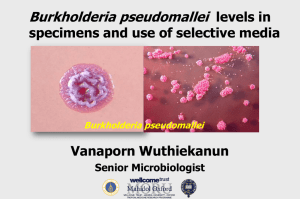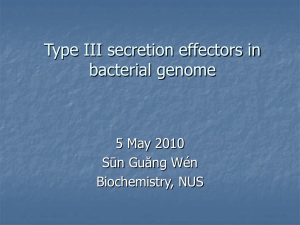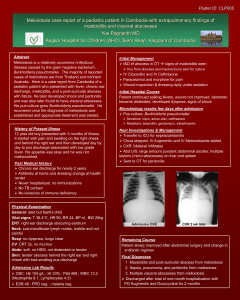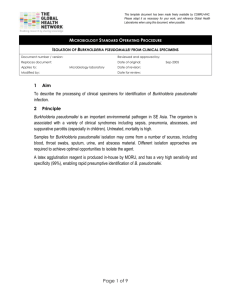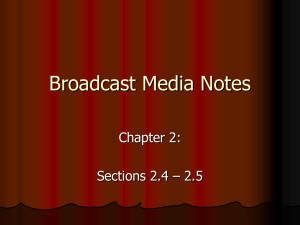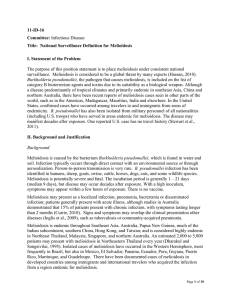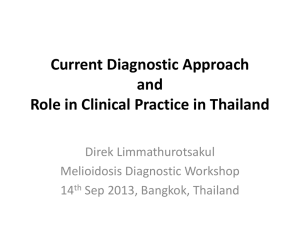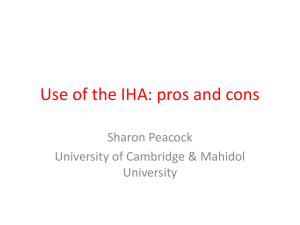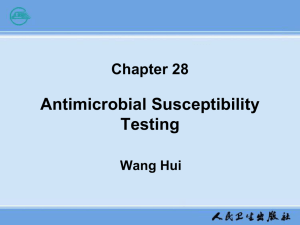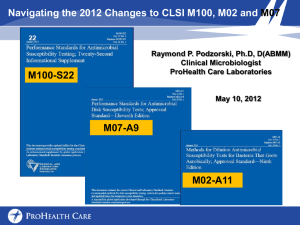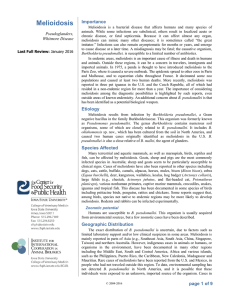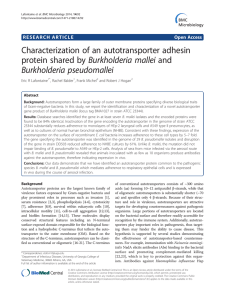PPT Abridged 1
advertisement
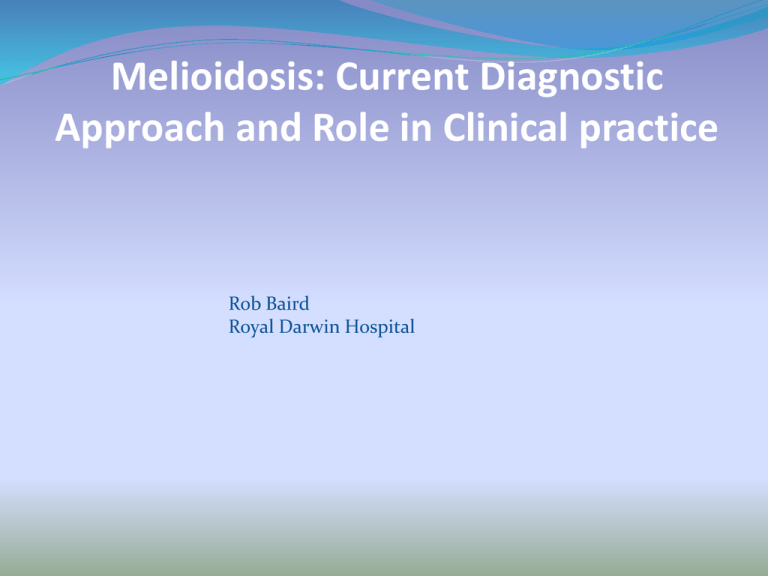
Melioidosis: Current Diagnostic Approach and Role in Clinical practice Rob Baird Royal Darwin Hospital The Darwin Prospective Melioidosis Study 820 cases over 24 years 109 deaths (13%) Darwin B. pseudomallei : Selective culture Colonies are small, light blue and dry on Ashdown agar. Typical wrinkled colonies after 72 hours incubation. B. pseudomallei : Selective culture Ashdown Broth contains colymycin and crystal violet to suppress Gram positive bacteria and common coliforms Used for screening purposes, and when melioidosis is suspected. Screening is performed mainly on throat and rectal swabs but also on sputum, urine or wound swabs. • • Broths are incubated 35 degrees C for 5 days – with lids loosened, then subbed to Ashdown agar. Broths are checked daily. Note: the positive is suggested by a growth at the air/broth interface, for this aerobic bacteria Different diagnostics: Acute disease: Blood v swabs v sputum Chronic disease: exposure B. Pseudomallei diagnostic algorithms at Royal Darwin Hospital: One for blood cultures, one for plate cultures Blood culture signals Plate culture growth Microscopy Gram stain Microscopy Gram stain Oxidase Agglutination Highly motile, bipolar staining Highly motile, bipolar staining, oxidase positive, agglutinates PCR Biochemistry ID Susceptibility testing PCR Doctor notified Possible, probable, confirmed Biochemistry ID Susceptibility testing B. pseudomallei: Susceptibility testing Susceptibility testing of B. pseudomallei isolates is performed to detect resistance to the antimicrobials used in therapy. Resistance in Northern Territory bacterial isolates is rare but described. Susceptibility methods for testing B. pseudomallei isolates, unlike most common bacteria are more limited, as there are no disc diameter zone sizes available in CLSI and EUCAST methodologies, and automated susceptibility systems such as Vitek 2, produce results which are partially indicative but do not good correlations with formal MIC testing. The gold standard is agar micro dilution, however E tests are widely available and correlate well with agar microdilution MIC’s. The links below are illustrative: Etest MIC testing methods and interpretation for B. pseudomallei Pooled MIC data for > 230 Northern Territory patient B. pseudomallei isolates from 2009-2012: Ceftazidime Meropenem Trimethoprim-sulphamethoxazole Doxycycline B. pseudomallei : E test interpretation Ceftazidime Meropenem Trimethoprim/Sulphamethoxazole E test result 1.5 mg/L E test result 1.0 mg/L E test result 0.125 mg/L Performed by CLSI method Meropenem, and ceftazidime give clear-cut end-points and are read at complete inhibition, as compared to trimethoprim/sulphamethoxazole B. pseudomallei : E test interpretation Trimethoprim/sulphamethoxazole 1.0mg/L Routine antimicrobial testing of melioid isolates by Etest is performed for meropenem, ceftazidime, trimethoprim/sulphamethoxazole and doxycycline. Performed by CLSI method Meropenem, ceftazidime and doxycycline give clearcut end-points and are read at complete inhibition. Trimethoprim/sulphamethoxazole does not have clear cut endpoint The MIC value is taken at 80% inhibition. Picture on left shows the 2 inhibition ellipses. The first one at 0.19 mg/L The second at about 1.5mg/L Therefore at 80% inhibition the MIC is 1.0 mg/L MIC above 2.0mg/L is resistant B. Pseudomallei: Pooled MIC data 2009-2012
